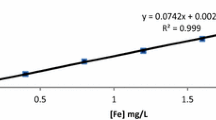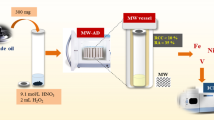Abstract
The determination of mercury in crude oil and petroleum products is particularly difficult due to the volatile nature of both mercury and the matrix, which may lead to significant loss of the analyte. A simple extraction method for total mercury has been developed to determine total mercury in crude oil using cold vapor atomic fluorescence spectrometry. The homogenized crude oil sample was diluted to 5, 10, and 20 % (w/w) in toluene. The diluted crude oil samples were spiked with 10 and 40 μg/kg (w/w). The samples were extracted using an oxidant/acid solution, BrCl/HCl. The mercury was extracted into the aqueous phase; the ionic mercury was then reduced to volatile elemental mercury (Hg0) by stannous chloride (SnCl2). The mercury vapor was detected by Merlin cold vapor atomic fluorescence spectrometry at a 253.7-nm wavelength. The average recoveries for mercury in spiked diluted crude oil (10 and 40 μg/kg, w/w) were between 96 and 103 %, respectively, in 5 and 10 % spiked diluted crude oil. Whereas, low recoveries (<50 %) were recorded in 20 % diluted spiked crude oil. The method detection limit was calculated as t (0.01)(n − 1) × SD where t is the student's value for 99 % confidence level and standard deviation estimate with n − 1 degrees of freedom. The method detection limit was found to be 0.38 μg/kg based on 5 g of diluted crude oil sample. The method is sensitive enough to determine low levels of mercury in crude oil.


Similar content being viewed by others
References
Al-Gadi, A. A., & Al-Swaidan, H. M. (1990). Determination of vanadium in Saudi Arabian crude oil by inductively coupled plasma mass spectrometry (ICP/MS). Analytical Letters, 23(9), 1757–1764.
Al-Swaidan, H. A. (1990). Trace metals determination by wet ashing ICP-MS in Saudi Arabian crude oils. Analytical Letters, 23(7), 1345–1356.
Barrera, P. B., Pita Calvo, C., & Bermejo Martinez, Y. F. (1991). Sample preparation procedures for vanadium determination in petroleum by atomic absorption spectrometry with electro-thermal atomization. Analytical Letters, 24(3), 447–458.
Bloom, N. S. (2000). Analysis and stability of mercury speciation in petroleum hydrocarbons. Fresenius' Journal of Analytical Chemistry, 366, 438–443.
Clesceri, L.S., Greenberg, A.E., Eaton, A.D. (1998). Method detection level. In Standard methods for the examination of water and wastewater, 20th edition, Baltimore: American Public Health Association, American Water Works Association.
Liang, L., Horvat, M., & Danilchik, P. (1996). A novel analytical method for determination of pictogram levels of total mercury in gasoline and other petroleum based products. Science of the Total Environment, 187, 57–64.
Lord, C. J., III. (1991). Determination of trace in crude oil by inductively coupled plasma mass spectrometry with microemulsion sample introduction. Analytical Chemistry, 63, 1594–1599.
Morales Rubio, A. (1990). Flame atomic absorption spectrometric determination of iron, nickel, cobalt and molybdenum in petroleum industry catalysts after microwave digestion. Analytica Chimica Acta, 235, 405–411.
Torre, M., Gonzales, M. C., Jimenez, O., & Rodriguez, A. R. (1990). Study of analytical methods for iron determination in complex organic liquids by atomic absorption spectrometry. Analytical Letters, 23(8), 1519–1536.
Turunen, M., Peraniemi, S., Ahlgren, M., & Westerholm, H. (1995). Determination of trace elements in heavy oil samples by graphite furnace and cold vapor atomic absorption spectrometry after acid digestion. Analytica Chimica Acta, 311, 85–91.
Wilhelm, S. M., & Bloom, N. S. (2000). Mercury in petroleum. Fuel Processing Technology, 63(1), 1–27.
Wilhelm, S. M., Liang, L., & Kirchgessner, D. (2006). Identification and properties of mercury species in crude oil. Energy & Fuels, 20, 180–186.
Acknowledgments
The authors would like to thank the management of Saudi Aramco for the permission to publish the results in this article. Mr. Abdulelah A. Al-Naser is acknowledged for his kind support. The authors also wish to thank for the helpful suggestions of Syed M. Bukhari.
Author information
Authors and Affiliations
Corresponding author
Rights and permissions
About this article
Cite this article
Uddin, R., Al-Fahad, M.A., Al-Rashwan, A.K. et al. A simple extraction procedure for determination of total mercury in crude oil. Environ Monit Assess 185, 3681–3685 (2013). https://doi.org/10.1007/s10661-012-2819-2
Received:
Accepted:
Published:
Issue Date:
DOI: https://doi.org/10.1007/s10661-012-2819-2




